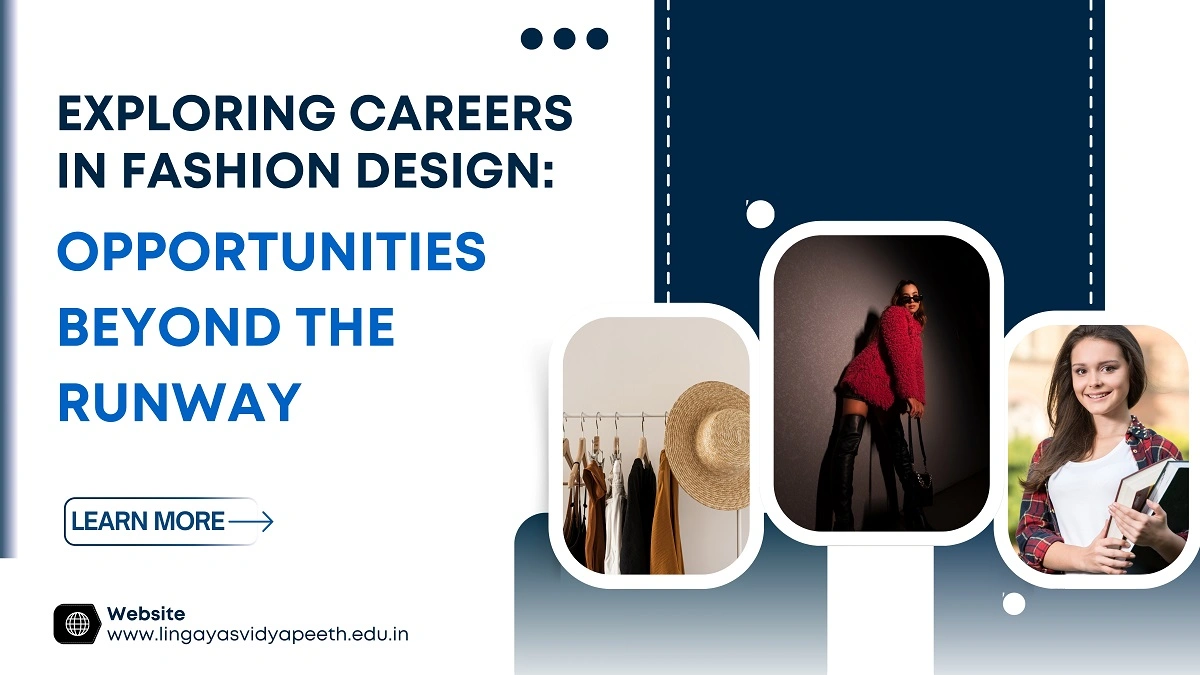Home » Exploring Careers in Fashion Design: Opportunities Beyond the Runway

Fashion design is more than just creating beautiful clothes — it’s a dynamic industry that combines creativity, culture, technology, and business. With the rise of digital fashion, sustainable fashion, and global fashion trends, career opportunities for fashion design graduates have never been more diverse or exciting.
At the core of the industry, a fashion designer develops original clothing, accessories, and footwear. Designers research trends, sketch ideas, select fabrics, and oversee the production process. Depending on their expertise, designers may specialize in:
Some designers join fashion houses, while others launch their own fashion labels.
A fashion illustrator translates concepts into sketches and visual representations. This role is vital in the early stages of design development, presentations, and promotional materials. Strong skills in proportions, color theory, and digital illustration software are essential.
Fashion stylists collaborate with designers, brands, celebrities, and publications to create complete looks for:
Career paths include celebrity styling, editorial styling, commercial/advertising styling, and personal shopping or image consulting. Knowledge of body types, color coordination, and current trends is crucial.
Textile designers develop fabrics and patterns that form the foundation of fashion collections. This can include digital printing, embroidery, or sustainable materials, blending traditional techniques with modern innovation.
Fashion merchandising combines artistic vision with market strategy. Merchandisers analyze trends, forecast demand, plan product lines, and manage pricing and inventory. They work closely with designers and buyers to ensure collections meet market demand.
This role suits those with a creative eye and strong business sense.
Fashion buyers decide which products retail stores should stock based on consumer demand, seasonal trends, and brand alignment. They collaborate with designers, suppliers, and merchandisers to curate a perfect product mix for their brand or retail chain.
Costume designers create outfits for film, television, theater, and web series. They must understand narrative, character development, historical periods, and production logistics. This role blends fashion with storytelling and drama.
Fashion photographers work on campaigns, editorials, lookbooks, and e-commerce shoots. Strong visual sense, technical skills, and collaboration with models and stylists are crucial in this creative career.
Social media has opened new career paths. Fashion graduates can become influencers, bloggers, or content creators, collaborating with brands through affiliate marketing, sponsored content, and online campaigns.
Visual merchandisers create eye-catching store displays and layouts that drive sales and reflect a brand’s identity. They combine art, design, and retail strategy to enhance the customer experience in physical stores.
Many designers pursue entrepreneurship, launching clothing lines, accessories brands, or sustainable fashion ventures. This path requires design skills, business knowledge, and marketing expertise. Trending areas include fashion tech, rental fashion, upcycled fashion, and custom tailoring.
With growing concern for the environment, brands are hiring sustainability experts to guide eco-friendly production, sourcing, and circular fashion models. This career offers meaningful work with high industry demand.
Technology is transforming fashion. CAD designers use computer-aided design tools, pattern-making software, and wearable tech to create innovative designs. Careers in digital fashion, virtual try-ons, and AI-assisted design are rapidly expanding.
Experienced professionals can become fashion educators, teaching design institutes and mentoring aspiring designers. This role is ideal for those passionate about academic fashion and mentorship.
Fashion journalists write, edit, and report on trends, designers, and fashion weeks for magazines, newspapers, and online platforms. Editors play a key role in content curation, brand tone, and visual identity in fashion publications.
Fashion design is more than sketches and sewing — it’s a versatile, thriving industry with diverse career opportunities. With the rise of e-commerce, digital fashion, and sustainable practices, skilled professionals are in high demand.
Whether you aim to design couture gowns, manage luxury brands, or build a sustainable fashion label, the industry offers paths that align with your passion and skills. Stay curious, build your portfolio, attend workshops, and keep learning. Most importantly, believe in your vision — because the future of fashion belongs to bold, innovative thinkers like you.
Also Read
Top Career Options After Fashion Design
Fashion designing courses after 12th
From
Riya Kapoor
Assistant Professor
School of Fashion Design
RECENT POSTS
CATEGORIES
TAGS
Agriculture Agriculture future AI Architecture artificial intelligence Bachelor of Commerce BA English BA Psychology BTech AIML BTech CSE BTech cybersecurity BTech Engineering Business management career Career-Specific Education career guide career option career scope Civil engineering commerce and management Computer Science Computer science engineering Data science degree education Engineering Engineering students English Literature english program Fashion Design Fashion design course Higher Education Journalism journalism and mass communication law Law career Machine Learning mathematics MBA MBA specialization Mechanical Engineering Pharmacy Psychology Research and Development students
Nachauli, Jasana Road, Faridabad, Haryana
Address: C-72, Second Floor, Shivalik, Near Malviya Nagar,
Above HDFC Bank, New Delhi 110017
Landline No. - 011-46570515 / 45138169 / 41755703
Mobile No. - +91-7303152412 / +91-7303152420 / +91-9311321952
Toll Free: 1800-120-4613
Mobile : 8447744303 | 8447744304 | 8447744306 | 8447744309
8700003974 | 8700003411 | 8700003749
Copyrights © 1998 - 2026 Lingaya's Vidyapeeth (Deemed To Be University). All rights reserved.
LV only conducts physical/online verification of any document related to examination on the following email id:
It is important to note that the following email IDs and domains are fraudulent and do not belong to our university.